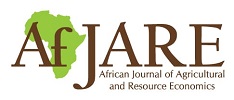


African Journal of Agricultural and Resource Economics (AfJARE)
A publication of the African Association of Agricultural Economists (AAAE)
Latest Publications
Effect of farmer–herder conflict adaptation strategies on multidimensional poverty and subjective wellbeing in Ghana
Farmer–herder conflicts deepen the incidence of poverty and worsen the wellbeing of both farming and herding households in Sub-Saharan Africa. In order to cope with the effects of conflict on their livelihoods, households adopt various adaptation strategies.
Food security gains from the adoption of improved maize varieties among smallholder households in Uganda: A panel analytical framework
This study investigated the food security effect of the adoption of improved maize varieties among farming households in Uganda using four waves of the Uganda National Panel Survey (UNPS) spanning the period 2013 to 2020.
Does adoption of improved soybean varieties and their complementary agronomic practices enhance household food security among smallholder farmers in Malawi
Soybean is one of the key legume crops that provides several financial benefits for farming households in Malawi. However, Malawi's persisting efforts to improve smallholder productivity and diversification have only translated into moderate improvements in food security outcomes.
The literature on what drives crop failure and crop abandonment is scant. This paper explores the interplay between risk factors and crop abandonment. We examine the role of risk sources and risk management strategies in crop abandonment by smallholder maize farmers in Zambia.
Knowledge, attitudes and risk management strategies among maize farmers in the Equatoria region of South Sudan
This study investigates risk perceptions and management strategies among maize growers in the equatorial region of South Sudan. A cross-sectional study design included a survey questionnaire that was used to analyse data from 510 respondents.
Impact des chocs agro-climatiques sur la sécurité alimentaire desménages ruraux au Sénégal
Cet article analyse l’impact des chocs agro-climatiques sur la sécurité alimentaire des ménages ruraux sénégalais à l'aide d'un modèle probit ordonné. La méthode du score de consommation alimentaire est utilisée pour appréhender l'état de la sécurité alimentaire des ménages. L’étude montre que 14% des ménages vivant en milieu rural sont à consommation alimentaire faible, 17% à consommation alimentaire limite, et 69% à consommation alimentaire acceptable.
Volume 19
Farmer–herder conflicts deepen the incidence of poverty and worsen the wellbeing of both farming and herding households in Sub-Saharan Africa. In order to cope with the effects of conflict on their livelihoods, households adopt various adaptation strategies.
The current study investigated the impact of using information and communication technology-based weather information services on the adoption of climate change adaptation strategies.
Volume 18 (2023)
Climate-smart agriculture (CSA) is viewed as a potentially effective intervention to address low agricultural productivity in Sub-Saharan Africa (SSA), while strengthening farmers’ capacity to adapt to the effects of climate change.
Poultry waste management and the energy demand have generated environmental and climate change concerns. Experts have suggested converting poultry waste to biogas energy through recycling to reduce these concerns.
Cette étude examine l'impact économique de l'utilisation des semences améliorées sur la sécurité alimentaire des ménages ruraux au Cameroun.
Volume 17 (2022)
Cette étude analyse l’efficacité des producteurs de riz dans l’allocation des ressources dont ils disposent pour la production en recueillant des données transversales auprès de 255 producteurs dans le Centre-Ouest de la Côte d’Ivoire.
Current global trends in population growth, urbanisation and a growing middle-class economy have resulted in increased demand for livestock and products, and more so dairy products. This necessitates the need for livestock producers to respond to the growing demand.
This article analyses the level of integration in pastoral markets in Kenya using high-frequency data generated through a crowdsourcing endeavour. The vector error-correction model framework was used to estimate the causal relationships between the short- and long-run market price.


